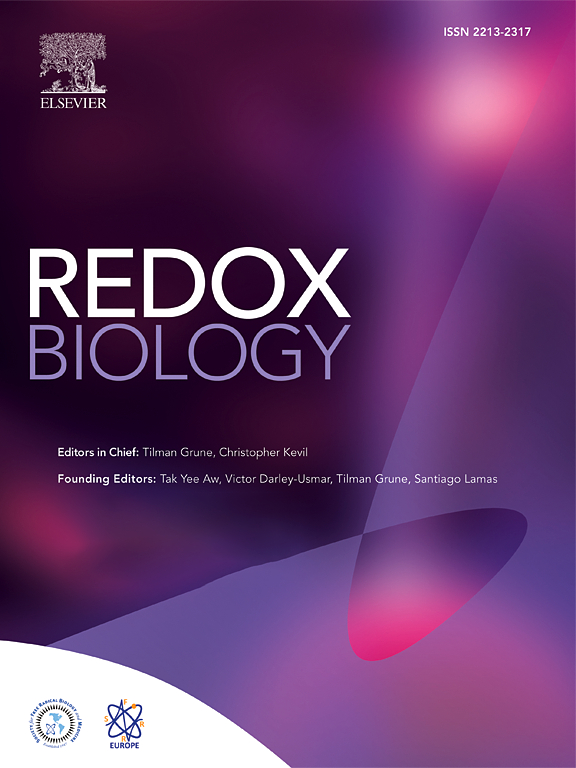ATF7IP inhibits Sorafenib-induced ferroptosis in hepatocellular carcinoma cells by inhibiting CYB5R2 transcription and stabilizing PARK7 protein
IF 11.9
1区 生物学
Q1 BIOCHEMISTRY & MOLECULAR BIOLOGY
引用次数: 0
Abstract
Ferroptosis, an iron-dependent form of programmed cell death, arises from the accumulation of lipid peroxides at toxic levels. Sorafenib, a first-line treatment for advanced hepatocellular carcinoma, shows limited clinical efficacy due to drug resistance. However, the mechanisms underlying Sorafenib resistance, especially related to ferroptosis, remain poorly understood. In this study, we identify activating transcription factor 7-interacting protein (ATF7IP) as a key inhibitor of ferroptosis. ATF7IP depletion promotes Sorafenib-induced ferroptosis, resulting in decreased cell viability, reduced cellular glutathione (GSH) levels, increased lipid peroxidation, and altered mitochondrial crista structure. Notably, ATF7IP knockdown shows cooperative effects with Sorafenib in inhibiting hepatocellular carcinoma growth in mice. Mechanistically, ATF7IP interacts with SET domain bifurcated histone lysine methyltransferase 1 (SETDB1) to epigenetically silence the transcription of cytochrome b5 reductase 2 (CYB5R2), thereby reducing cellular Fe2+ levels. Meanwhile, ATF7IP stabilizes the antioxidant sensor Parkinsonism-associated deglycase (PARK7) protein which preserves the transsulfuration pathway to produce GSH, also leading to the inhibition of Sorafenib-induced ferroptosis. In conclusion, our findings identify ATF7IP as a critical ferroptosis inhibitor and represent ATF7IP as a novel therapeutic target for Sorafenib-based combination therapies of hepatocellular carcinoma.

ATF7IP通过抑制CYB5R2转录和稳定PARK7蛋白抑制sorafenib诱导的肝癌细胞铁下垂
铁死亡是一种依赖铁的程序性细胞死亡形式,起源于脂质过氧化物在毒性水平的积累。索拉非尼是晚期肝癌的一线治疗药物,但由于耐药,临床疗效有限。然而,索拉非尼耐药的机制,特别是与铁下垂有关的机制,仍然知之甚少。在这项研究中,我们发现激活转录因子7相互作用蛋白(ATF7IP)是铁下垂的关键抑制剂。ATF7IP耗竭促进索拉非尼诱导的铁凋亡,导致细胞活力下降,细胞谷胱甘肽(GSH)水平降低,脂质过氧化增加,线粒体嵴结构改变。值得注意的是,ATF7IP敲低与索拉非尼在抑制小鼠肝细胞癌生长方面具有协同作用。从机制上讲,ATF7IP与SET结构域分叉组蛋白赖氨酸甲基转移酶1 (SETDB1)相互作用,表观遗传地沉默细胞色素b5还原酶2 (CYB5R2)的转录,从而降低细胞铁离子水平。同时,ATF7IP稳定抗氧化传感器Parkinsonism-associated deglycase (PARK7)蛋白,该蛋白保留了产生GSH的转硫途径,也导致sorafenib诱导的铁凋亡受到抑制。总之,我们的研究结果确定ATF7IP是一种关键的铁下垂抑制剂,并代表ATF7IP是基于索拉非尼的肝细胞癌联合治疗的新治疗靶点。
本文章由计算机程序翻译,如有差异,请以英文原文为准。
求助全文
约1分钟内获得全文
求助全文
来源期刊

Redox Biology
BIOCHEMISTRY & MOLECULAR BIOLOGY-
CiteScore
19.90
自引率
3.50%
发文量
318
审稿时长
25 days
期刊介绍:
Redox Biology is the official journal of the Society for Redox Biology and Medicine and the Society for Free Radical Research-Europe. It is also affiliated with the International Society for Free Radical Research (SFRRI). This journal serves as a platform for publishing pioneering research, innovative methods, and comprehensive review articles in the field of redox biology, encompassing both health and disease.
Redox Biology welcomes various forms of contributions, including research articles (short or full communications), methods, mini-reviews, and commentaries. Through its diverse range of published content, Redox Biology aims to foster advancements and insights in the understanding of redox biology and its implications.
 求助内容:
求助内容: 应助结果提醒方式:
应助结果提醒方式:


